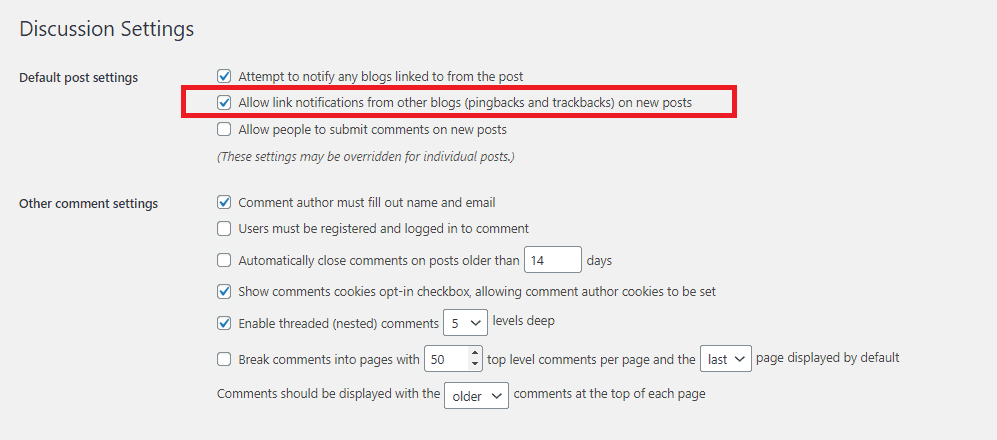Pingbacks and trackbacks in WordPress are two very similar terms that are not known to many users. Although these terms are not new and have been with WordPress since the beginning, still, the use of them is not done properly.
So, whether you’re an existing WordPress blogger or you are building a website from scratch, it is of great importance to know what pingbacks and trackbacks are.
To help you understand these terms, in this article, we have explained the meaning of pingbacks and trackbacks, their uses, the difference between them, and how to use them effectively. So here we go.
What are trackbacks in WordPress?
When you publish a blog post or article on your website and include an external link in the content, then a notification is sent to that external website. This notification is called a trackback.

Let’s explain this with an easy example. You have published a new post on your blog titled “top 5 tips for WordPress security” and have included an external link to another post that is called “best security plugins for WordPress”. The owner of that external blog will then get a notification in the comments section of their WordPress dashboard, or in other words a trackback.
This can grab the attention of the owner of that website. And if that person approves the trackback, then your post link with an excerpt will be posted as a comment underneath the post to which you have linked to.
What are pingbacks in WordPress?
Pingbacks are very similar to trackbacks, you could even call them an updated version of trackbacks. But the communication technology used for pingbacks is not the same one that is used for trackbacks.
When you publish a post on your own blog with an external link to some external blog post, then WordPress will automatically send a ping to the site hosting the external blog post.
The automatic ping is sent only if you have it enabled in your WordPress Settings and if the external site also has pingbacks enabled.
So, the external site will get the ping and might check your post to see if you have actually linked to them. This is because sometimes such things can also be a part of spam activities.
But once the link verification is done, the website owner can then approve your link, and it can be posted on their article as a comment. Generally, pingbacks include only the link of the post and not the excerpt of the post.
Difference between Trackbacks and Pingbacks

There are not many differences between trackbacks and pingbacks. Both do very similar work of notifying the owner of a website about a backlink to their blog post that is included on another website’s blog post. The main difference is in the method of notifying.
While trackbacks in WordPress are done manually, pingbacks are done in an automated manner. Hence, there is a difference in the communication technology that is being used.
The next difference is that trackbacks include an excerpt from a blog post along with its link, but pingbacks only include a link.
Important things to know about pingbacks and trackbacks in WordPress

1. Pingbacks are sent automatically whenever a link is added in any external blog post
As mentioned above, pingbacks work in an automated manner. But the automation comes into existence only if the external website has pinbacks enabled it the Settings.
So, allowing and approving a pingback related to your post depends on the owner of the external website to which you have linked to.
If a website owner has not enabled pingbacks on their site and you want to notify them about the link included in your post, then you can do it manually using the trackback option.
2. Some themes come with custom trackback features
Sometimes, both the automatic and manual notifications about the external links also depend on the WordPress theme being used. But most bloggers nowadays choose to utilize the trackback and pingback features in order to boost traffic.
If the external websites haven’t enabled pingbacks, then they go for the trackback feature. But one thing that should be emphasized is that linking to the same websites multiple times can cause negative results, as the external websites might see you as a spammer.
3. It’s not necessary to approve pingbacks and trackbacks

A lot of the time, pingbacks and trackbacks are used as a technique by spammers. They try to use them for malicious and wrong purposes. So, it’s not necessary for you to approve such comments.
If you do get notifications about pingbacks and trackbacks, then try to have a look and see if they are in fact credible. If anything looks suspicious or questionable, then it will be better to ignore and trash it.
Don’t ever take the chance of putting your website at risk. Because it can not only cause security issues but also impact your SEO (search engine optimization). Exactly this is the reason why many bloggers choose to disable trackbacks and pingbacks and use a VPN solution to keep connections private.
4. Trackbacks and pingbacks can help you find content theft
Sometimes, trackbacks and pingbacks can actually help you find out if someone is stealing your content. This is very useful because there are many websites and blogs today that copy the content from other sites and paste it onto theirs.
In many cases, they don’t even remove the internal links that you use in your posts. So your internal links then become external links for their site, meaning you will receive a notification for the same.
You can then check and see if they are in fact stealing your content. If that is the case, report their website, and protect your content from theft.
Wrapping up
We hope this article helped you understand what are pingbacks and trackbacks in WordPress, the difference between these terms, how to use them for your benefit, and when to avoid using them.
If you have any questions regarding the concept of trackbacks and pingbacks, feel free to reach out to us using the comments below.
